�
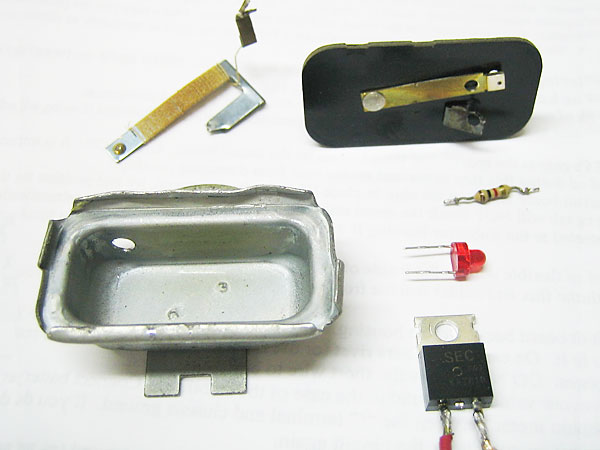
�
Upper left: the resistance-wire wrapped bimetallic element of an old-fashioned thermal voltage stabilizer.
�
Lower right: a solid-state electronic voltage regulator that can be used to replace it.
�
How To: Replace Your MGB's Lucas Thermal Voltage Stabilizer
�Install a Solid State Regulator Inside the Lucas Case
� as published in British V8 Magazine, Volume XVI Issue 2, September 2008�� text by: Curtis Jacobson
� photos by: Jim Miller�
�
� Notes: this article references MGB equipment, schematics, etc., and the information� may or may not be transferable to other vintage British sports cars. �
�Background Information
��
Are you still using your MGB's original fuel level and coolant temperature gauges?�
Unlike aftermarket gauges, these two old-fashioned gauges are simple "single-coil" �
devices. To work properly, they need to be used with an external "voltage stabilizer".�
Please refer to the schematic drawing below ("Stock MGB Voltage Stabilizer �
Circuit") for a quick illustration of how these instruments are wired into their �
respective circuits. According to the schematic, the gauges are designed to recieve �
a supply voltage of 10V (constant) from a device called a voltage stabilizer. The �
fuel level and coolant temperature sensors, downstream of their respective gauges, �
are connected through their mountings to chassis/ground. The sensors act like �
"variable resistors" - the resistance changes with fuel level or coolant temperature �
respectively. �
�
Reading from left to right, the first thing that we notice is that the voltage �
stabilizer itself is nominally provided 12V power. However, we know from experience �
that the voltage "in" isn't so stable or predictable! Any number of things could �
affect the supply voltage available including the battery's state of charge, the �
output of the generator or alternator at any given moment (which may be affected �
by engine RPM), and whether various loads on the system are on or off. �
�
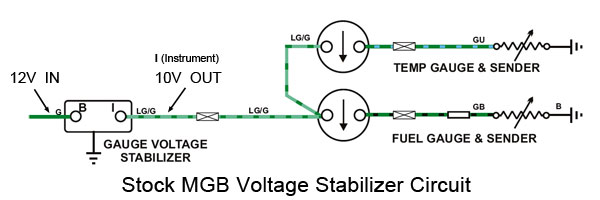
�
�
Regardless of how unstable or unpredictable the 12V power supply is, the �
voltage stabilizer's purpose is to iron things out. One conclusion you �
might reasonably take from the schematic is that: "If the voltage stabilizer �
provides more than 10V both gauges will read high, and if the voltage �
stabilizer provides less than 10V both gauges will read low." So, the voltage �
stabilizer provides the gauges a stable, accurate 10V input to work with, right? �
�
Not exactly! The original MG voltage stabilizer doesn't actually regulate �
voltage at all. Instead, it cycles power "on" and "off" to achieve an average �
voltage over time of about 10V. If you take an old-fashioned voltage stabilizer �
apart, you find a bimetallic element with a resistance wire wrapped around it, �
much like an "automatic reset circuit breaker". Heat in the resistance wire causes �
the bimetallic element to bend, rapidly opening and closing a set of contact points�
and thus switching between the nominal supply voltage of 12V and zero volts. �
That suits your old MGB gauges fine because your gauges have a lot of dampening �
built into them. If your gauges are sufficiently damped, you may not see their �
needles constantly wiggling as the voltage stabilizer chatters on and off; you'll �
only percieve the "average" readings that they're showing you. �
�
By modern standards, thermal voltage stabilizers aren't particularly accurate �
or consistent. (For example, their output varies a lot between summertime and �
wintertime because their accuracy is affected by ambient temperature. Their output �
also varies as the bimetallic element fatigues and as their internal contacts grow �
dirty.) If your voltage stabilizer needs replacement anyway, or if you just want �
to dramatically improve the accuracy and consistancy of your fuel level and coolant �
temperature gauges, you may want to consider converting to a modern solid-state �
electronic voltage regulator.�
�
Important note: if you replace your original MGB gauges with aftermarket gauges, �
you need to remove the old-fashioned thermal voltage stablizer. Modern gauges have �
a dual-coil design which provides accurate information regardless of supply voltage, �
but which may not be able to accomodate the abrupt on/off cycling of a thermal �
voltage stabilizer. �
Shopping List
��
Solid state voltage regulators are inexpensive, but they may be difficult to find �
locally. The easiest places to purchase them are online. "Google" the part numbers �
to identify potential suppliers.�
�
National Semiconductor's "LM2940T-10.0" and NTE Electronics' "NTE1953" are �
low dropout (LDO) solid-state voltage regulators. If you supply either of them �
with a DC voltage between 10.5V and about 30V, they will provide a constant output �
voltage of 10.0V. Similar to an old-fashioned bimetallic voltage stabilizer, they�
can't boost voltage: so if the supply voltage drops to below about 10.5V, these �
LDO's will "dropout" and simply pass through whatever supply voltage is available.�
�
Note: there are other alternative voltage regulators that could also be used. One �
example is Texas Instruments' part number "UA7810CKCS" (a.k.a. "7810" or "LM7810")�
which frankly you're probably more likely to find at your local Radio Shack. The �
main advantage of the National Semiconductor or NTE Electronics devices is their �
somewhat lower dropout specification.�
�
Optional: a small LED lamp and a 1000 ohm resistor. �
�
Also needed: just a few basics including a soldering iron, solder, about six inches of �
insulated wire, heat shrink tubing (or possibly electrical tape), etc.�
�
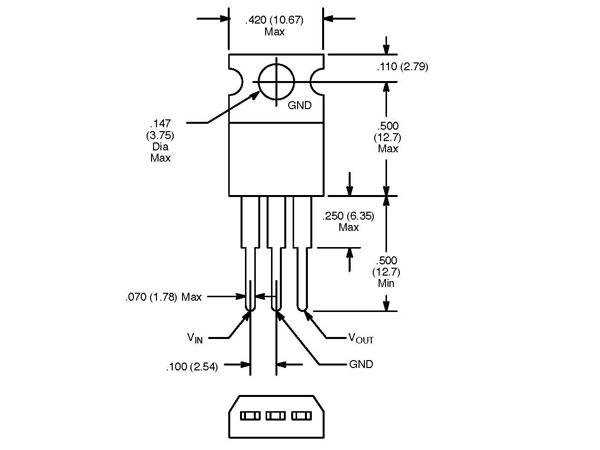
�
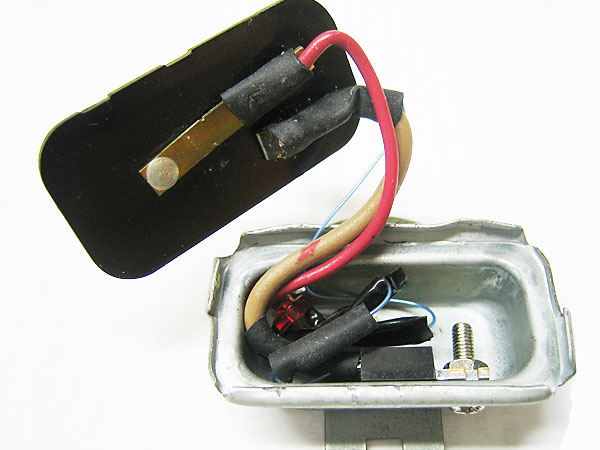
�
Directions
��
1. Disconnect the car's battery and remove the original voltage stabilizer �
from the car. (Note: the voltage stabilizer is mounted on the drivers-side �
firewall just above the steering column.)�
�
2. Open the voltage regulator by carefully prying back the tabs that clamp �
the metal cover to the plastic base.�
�
3. Cut and remove the old bimetallic regulator mechanism, being careful to �
leave enough of the two terminals for soldering wires onto them later. �
�
4. Prepare your solid-state voltage regulator by cutting off the center of �
its three terminals. (This terminal is nominally a "ground" connection, and it�
would be redundant with the mounting tab in our installation. They're connected �
internally...)�
�
Enjoying this article? Our magazine is funded through the generous support of readers like you!
�
To contribute to our operating budget, please click here and follow the instructions.
�
(Suggested contribution is twenty bucks per year. Feel free to give more!)�
�
5. Using a short length of wire, jumper between the solid-state voltage regulator's �
VIN (12V in) terminal to the "B" terminal on the plastic base. �
Carefully solder both connections.�
�
6. Using a short length of wire, jumper between the solid-state voltage regulator's �
VOUT (10V out) terminal to the "I" terminal on the plastic base. �
Carefully solder both connections.�
�
7. The LED indicator is optional. It is connected between the 10V OUT �
terminal and ground through a 1000 Ohm resister.�
�
8. To function properly, the solid-state regulator must be electrically �
well-grounded to the rest of the vehicle. Accomplish this by (first) connecting �
it to the voltage regulator's metal cover with a machine screw and nut. Note: �
the voltage regulator itself must in turn be grounded to the car by its mounting. �
If the fasteners are corroded or dirty, they should be cleaned at this time. �
�
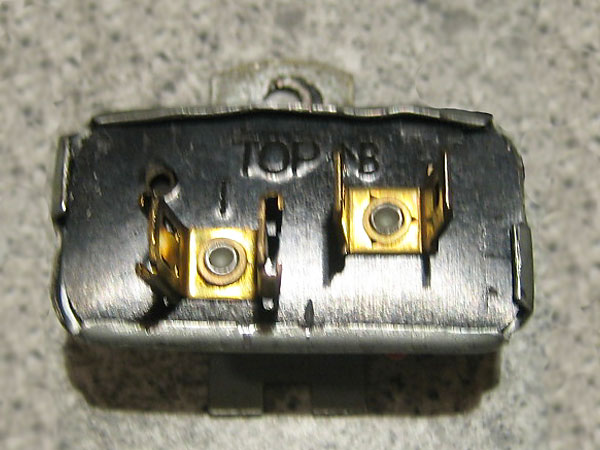
�
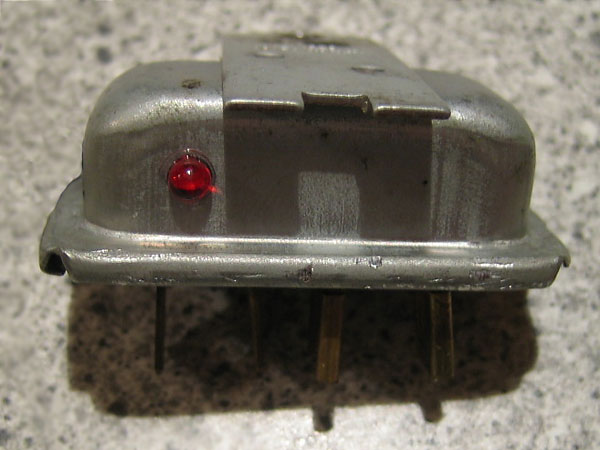
�
� �
�� � � �
�� Disclaimer: This page was researched and written by Curtis Jacobson and Jim Miller. � Views expressed are those of the authors, and are provided without warrantee or guarantee. � Apply at your own risk.�
� Photos by Jim Miller for British V8 Magazine. All rights reserved. �

